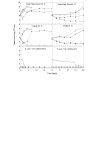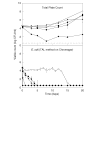Carvacrol and p-cymene inactivate Escherichia coli O157:H7 in apple juice
- PMID: 15963233
- PMCID: PMC1166557
- DOI: 10.1186/1471-2180-5-36
Carvacrol and p-cymene inactivate Escherichia coli O157:H7 in apple juice
Abstract
Background: Outbreaks of food poisoning associated with drinking un-pasteurised apple juice contaminated with enterohaemorrhagic Escherichia coli O157:H7 are a cause of serious illness and occasionally death. Whilst a well-established heat process (pasteurisation) will readily eliminate the pathogen, some consumers are demanding more fresh-like foods that have not been subjected to processing methods that are perceived as severe and may lead to loss of flavour and vitamins. Therefore, alternative methods are being investigated to replace pasteurisation and improve the safety of minimally-processed juices. The addition of natural antimicrobial substances such as the phenolic substances carvacrol and p-cymene (derived from the essential oils of herbs and spices) provides a potential new route to assure safety and extend the shelf-life of raw fruit juices. The aim of this study was to evaluate the addition of very low concentrations (0.25-1.25 mM) of carvacrol and p-cymene both individually and in combination as a novel means of controlling Escherichia coli O157:H7 in un-pasteurised apple juice.
Results: When inoculated at a level of 4 log CFU/ml into un-pasteurised apple juice (pH 3.20 +/- 0.06), Escherichia coli O157:H7 survived for up to 3 and 19 days at 25 degrees and 4 degrees C, respectively. Treatment of the juice with 1.25 mM carvacrol or p-cymene reduced the numbers of E. coli O157:H7 to undetectable levels within 1-2 days at both storage temperatures. The effective concentrations of carvacrol could be reduced even further by combining it at 0.5 mM with cymene at 0.25 mM. The phenolic compounds were biocidal against both spoilage yeasts and E. coli O157:H7 thereby increasing the shelf-life and improving the safety of un-pasteurised apple juice, particularly when stored at chill temperatures.
Conclusion: The results showed that the natural antimicrobial compounds carvacrol and p-cymene could potentially be used to extend the shelf life and improve the safety margins in un-pasteurised chilled fruit juices.
Figures


References
-
- Splittstoesser DF, Churey JJ Lee CY. Growth characteristics of aciduric sporeforming bacilli isolated from fruit juices. J Food Prot. 1994;57:1080–1083. - PubMed
-
- United States Food and Drug Administration Food labeling: warning and notice statements; labeling of juice products; final rule. Federal Register. 1998;63:37055–37056.
-
- Giese J. FDA issues juice guidelines. Food Technol. 2002;56:24.
Publication types
MeSH terms
Substances
LinkOut - more resources
Full Text Sources
Medical

